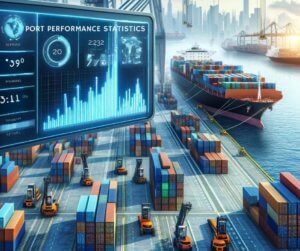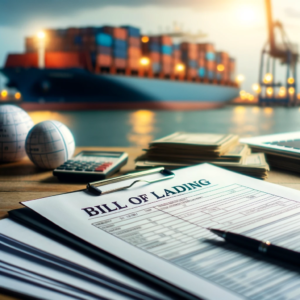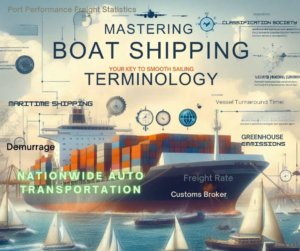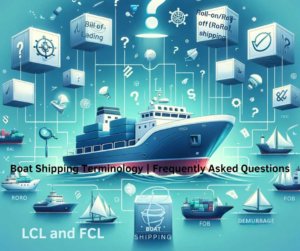
Reading Time: 7 minutes
Welcome to this informative guide on decoding boat shipping terminology and boat shipping rates! If you’re in the process of buying a boat and trying to navigate the complex world of maritime shipping, you’ve come to the right place. Understanding the terminology used in the boat shipping industry is crucial for ensuring a smooth and successful process.
Shipping a boat involves a variety of terms and concepts that may seem unfamiliar at first. From classification societies to greenhouse gas emissions targets, there’s a lot to learn. Don’t worry – this guide will break down the key words and provide you with the knowledge you need to make informed decisions.
Grab a cup of coffee, sit back, and let’s look into the fascinating world of boat shipping terminology!
In this guide, we will cover:
- The role of maritime shipping in global trade
- Key term: Classification Society
- Key term: Port Performance Freight Statistics
- Key term: Greenhouse Gas Emissions Targets
- Additional shipping terminology
By the end of this guide, you’ll have a solid understanding of these terms and be better equipped to navigate the boat shipping process. So, let’s get started!
Learn more about the intricacies of boat shipping and how Nationwide Auto Transportation ensures top-notch service on our Boat Shipping Guide.
Nationwide Auto Transportation

The Role of Maritime Shipping in Global Trade
Boat shipping terminology isn’t just jargon; it’s the language powering the world of maritime trade. This industry, crucial to global commerce, is responsible for moving around 80% of all items we use daily. Imagine this: the car you drive, the phone in your hand, the food on your table, and the clothes you wear – most have journeyed across oceans, all thanks to boat shipping.
Why does boat shipping take center stage in global trade, handling about 90% of it? Here’s a quick breakdown:
- Cost-Effectiveness: Shipping by sea often slashes costs compared to air or land transport.
- High Volume Capability: Ships are designed to transport large quantities, making them the go-to for bulk shipments.
Maritime shipping, a key element in understanding boat shipping terminology, is more than just moving goods. It’s a complex mix of shipbuilding, port operations, logistics, and vessel management. Central to this industry is the transportation of goods across vast oceans, utilizing various types of vessels like container ships, bulk carriers, tanker ships, and roll-on/roll-off vessels.
The efficiency and affordability of maritime shipping, a vital component of boat shipping rates, hinge on several factors:
- Port Operations: The smooth functioning of ports.
- Vessel Classification: Ships meeting specific safety and environmental benchmarks.
- Environmental Considerations: The shipping industry’s environmental footprint.
For those delving into the boat shipping glossary, understanding these terms and concepts is crucial. Whether it’s grappling with boat transport cost or the nuances of nautical shipping terminology, a clear understanding is key. Ready to set sail on this journey through the world of boat shipping terminology? Let’s explore these critical terms!
Key Terms in Maritime Shipping: Classification Society
| Aspect | Details |
|---|---|
| Definition | A Classification Society certifies ship safety and compliance with international regulations. |
| Example | American Bureau of Shipping (ABS): A notable society, ensuring ship safety since 1862. |
| Role | Assesses ships for structural strength and stability; issues seaworthiness certificates. |
| Safety Importance | Conducts inspections and audits, reducing risks of accidents at sea. |
| Risk Management | Offers guidance and risk assessments for safer maritime operations. |
| Upholding Standards | Works with bodies like IMO to maintain global shipbuilding and operational standards. |
| Buyer Benefits | Buyers gain confidence knowing ships meet rigorous safety and compliance standards. |
In essence, Classification Societies are key in maritime shipping, enhancing safety, compliance, and industry standards. Their role is crucial in ensuring the integrity of shipping operations, particularly important for buyers considering boat shipping rates. As a result, understanding this term enriches your grasp of boat shipping terminology.

Key Term: Port Performance Freight Statistics
When it comes to understanding the efficiency and effectiveness of a port, Port Performance Freight Statistics play a crucial role. These statistics provide valuable insights into the operations of a port and help measure its performance. In this section, we will explore what Port Performance Freight Statistics entail. Not only that, but we also see why they are important for buyers in the shipping industry.
Gain deeper insight into port operations and statistics! Explore the Bureau of Transportation Statistics.
boat terminology | What are Port Performance Freight Statistics?
Port Performance Freight Statistics is the collection and analysis of data related to the movement of freight in and out of a port. This data not only includes information on vessel arrivals and departures, but also cargo handling and container throughput. There are also many other key performance indicators. These statistics provide a comprehensive overview of a port’s operations and efficiency.
Importance of Port Performance Freight Statistics Simplified
Why They Matter:
- Assessing Efficiency: These statistics help buyers evaluate a port’s efficiency using key performance indicators, aiding in smarter port selection.
- Port Comparison: Buyers can compare different ports, identifying those with superior services and quicker processes, leading to supply chain optimization and cost reduction.
- Spotting Issues: Analyzing these stats reveals bottlenecks and improvement areas in port operations, fostering collaboration with port authorities for enhanced efficiency.
Key Metrics to Know:
- Vessel Turnaround Time: Shorter times mean higher efficiency.
- Container Throughput: More containers handled indicates greater capacity.
- Berth Occupancy Rate: High rates show effective port utilization.
- Cargo Handling Productivity: Efficiency reflected in crane operation speed and cargo handling time.
In short, Port Performance Freight Statistics are vital for making informed shipping decisions. They offer insights into a port’s efficiency. This helps buyers streamline their shipping strategies and improve maritime logistics.
For comprehensive information on global efforts in reducing shipping emissions, explore the resources available at the Environmental Protection Agency’s official website.
Greenhouse Gas Emissions in Maritime Shipping

Understanding GHG Emissions:
- What They Are: Gases like CO2, CH4, N2O trap heat, changing the climate.
- Shipping’s Role: Auto and boat shipping add 2-3% to the world’s GHG emissions.
IMO’s Emission Reduction Goals:
- The Target: Slash shipping’s GHG emissions by half by 2050, from 2008 levels.
- Why It Matters: This aligns with global goals to limit temperature rise. As a matter of fact, it was stated in the Paris Agreement.
How to Reduce Emissions:
- Energy Efficiency: New ships must be more fuel-efficient, meeting the Energy Efficiency Design Index (EEDI).
- Improving Ship Efficiency: The Ship Energy Efficiency Management Plan (SEEMP) requires ships to operate more efficiently.
- Alternative Fuels: Push for cleaner fuels, like LNG, and encourage new fuel tech.
- Market Strategies: Considering carbon pricing to push for lower emissions.
- Working Together: Encourages a team effort in the industry for better emission control.
Benefits of Emission Reduction:
- For the Environment: Reduces climate impact, protecting future generations.
- Health and Air Quality: Better air quality helps people living near ports and shipping routes.
- Saving Money: Fuel-efficient ships cut costs for shipping companies.
- Spurring Innovation: Leads to new, better technologies in shipping.
Simplified Guide to Additional Shipping Terminology

| Term | Definition |
|---|---|
| Bill of Lading (B/L) | A legal document from the carrier to the shipper. It confirms receipt of goods and outlines transport terms. All in all, acts as a shipment contract. |
| Freight Forwarder | A company or individual managing the transportation of goods for the shipper. Also, handles documentation, customs, and coordination. |
| Freight Rate | The cost charged for transporting goods, based on distance, weight, and cargo type. |
| Containerization | Basically, packing goods in standardized containers for efficient transport and easy transfer between ships, trucks, and trains. |
| Incoterms | International Commercial Terms defining buyers’ and sellers’ responsibilities in trade, including transport, insurance, and customs. |
| Demurrage | Charges for cargo delays beyond the agreed time at loading or unloading. As a result, it is important to avoid additional costs. |
| Customs Broker | A licensed professional specializing in customs regulations. Chiefly facilitating the clearance of goods through customs. |
| Sea Freight vs. Air Freight | Sea freight: Slower, cost-effective for heavy cargo. Air freight: Faster, pricier option for goods transport. |
Knowing these shipping terms helps you talk better with shipping companies. More so, it helps you make smart moves when shipping boats. This know-how really smooths out the shipping process.
Mastering Boat Shipping Terminology | Your Key to Smooth Sailing in Maritime Shipping

Understanding boat shipping terminology is vital, especially for those transporting vessels. By knowing terms like classification society, port performance freight statistics, and greenhouse gas emissions targets, you navigate maritime shipping like a pro.
Nationwide Auto Transportation excels in seamless vehicle shipping services. We ensure your boat’s safe, careful handling with our door-to-door service.
Explore Our Range of Shipping Services:
- Tulsa, OK to Los Angeles, CA: Discover our specialized route services.
- Contact Us: Have questions? Reach out for personalized support.
- Military Auto Transport: Dedicated services for military personnel.
- Boat Shipping: Expert handling for your boat transport needs.
- Car Shipping: Reliable and safe car transportation solutions.
- RV Shipping: Trust us with your recreational vehicle transport.
We’ve got you covered, whether it’s a car, motorcycle, boat, or any other vehicle. Rely on Nationwide Auto Transportation for a smooth, hassle-free shipping experience.
Ready to ship your boat or vehicle? Visit Nationwide Auto Transportation now to learn more and get a quote. Let’s make your shipping journey effortless!

Boat Shipping Terminology | Frequently Asked Questions
What is a Bill of Lading?
- It’s a legal document from the carrier to the shipper. In fact, it acts as a receipt, contract, and title document, detailing the shipment’s particulars like names, addresses, and goods descriptions.
Roll-on/Roll-off (RoRo) shipping. What does it mean?
- RoRo shipping is when cargo rolls on and off the vessel on its own wheels. The result makes it ideal for vehicle transport, including boats, due to its ease and cost efficiency.
What does FOB mean in boat shipping rates?
- FOB, or Free On Board, means the seller owns the goods until they’re loaded onto the vessel. After loading, the buyer takes over responsibility and risk.
Demurrage charge in boat shipping rates?
- Demurrage is a fee for cargo that stays at the port too long. It covers the carrier’s extended use of space and encourages quick cargo pickup.
How do LCL and FCL shipping differ?
- LCL (Less than Container Load) is for smaller shipments that don’t fill a container. FCL (Full Container Load) is when your goods fill an entire container, better for larger shipments.
Discover more about seamless military relocations with our comprehensive guide on Best Military Vehicle Shipping. Dive deeper into expert tips, detailed insights, and valuable advice that ensure your next military move is smooth and stress-free. Whether you’re exploring different transport options or seeking peace of mind for your vehicle’s journey, our guide has everything you need. Click now to learn more and make your military transition as seamless as possible.



